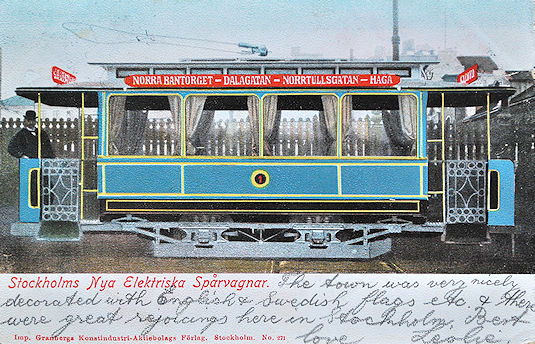

The horse tram era in Stockholm started on 10 July 1877 and a steam-operated line opened in 1887, all on standard gauge. Electric trams started to replace horse and steam in 1901 and, by 1905, the Stockholm horse tram was history. The tramways in this period from 1877 were operated by SNS (Stockholms Nya Spårvägsaktiebolag) and SSB (Stockholms Södra Spårvägsaktiebolag) up to 1917 and 1918 respectively. After that, ABSS (AB Stockholms Spårvägar) took over tram operations until 1966/67.
An extensive network of electric tram routes was established in the first half of the 20th century but many started to be replaced by the Stockholm Metro from 1950, especially those longer routes running out to the suburbs.Tram mileage declined until September 1967 when the remaining routes (except two substantially private right of way lines) were closed due to "Dagen H" ("H-Day"), when Sweden switched from left-hand traffic (as in the UK) to right-hand traffic (as in the rest of mainland Europe). It was thought too expensive to convert the old trams or to buy new ones.
Our card shows one of the new electric trams of 1901, although it is not certain that the postcard was printed at that time. The red number '1' on the side panel suggests this is tram 1 but, usually, the initials of the operating company appeared here and not a number. The first electric trams, numbered 1-21, were manufactured in 1901 by ASEA (Allmänna Svenska Elektriska Aktiebolaget), with trucks by UEG (Union Electricitäts Gesellschaft). They were designated 'Type A1' of width 2.18m, length 7.10m, weight 10.3t and fitted out with 18 seats and 23 standing places. In later years, they were rebuilt as enclosed cars and one (now no.76) survives in the museum fleet. The card was published by Granbergs Konstindustri-Aktiebolags Förlag, Stockholm, as card no.271. This is part of a short series of other cards depicting the new electric trams.
In 1991, a 2-mile heritage tram route was opened in Stockholm (the Djurgårdslinjen) using museum trams (e.g. no.76 referred to above) but this became the start of a second-generation tram system, which has expanded to several new routes with modern articulated, low-floor trams or light-rail vehicles. Today, ABSS operates the city tram routes 7, 7N and 21, while Arriva (at time of writing) runs the remaining light-rail lines.
This particular postcard has some interesting history attached to it. The message on the front reads, "The town was very nicely decorated with English & Swedish flags etc. and there were great rejoicings here in Stockholm". So, what was the occasion? The card was posted to England on 19 July 1905 to an address in Margate, interestingly with a "P.K.X.P. No.34" postmark; which is for a travelling post office. However, and of more relevance to the message, the Duke of Scania (Prince Gustaf Adolf of Sweden) had married his English bride, Princess Margaret of Connaught, at Windsor Castle on 15 June 1905 and later arrived in Sweden on 8 July. They then took up residence in the Royal Palace of Stockholm. Clearly, the writer of the card was describing the decorations in the city for this event. Margaret died in 1920 but the then Crown Prince of Sweden married Lady Louise Mountbatten (a relative of Margaret) in 1923. He acceded to the Swedish throne in 1950 as Gustaf VI Adolf and died in 1973.
![]() Go to Postcard Of The Month Index
Go to Postcard Of The Month Index